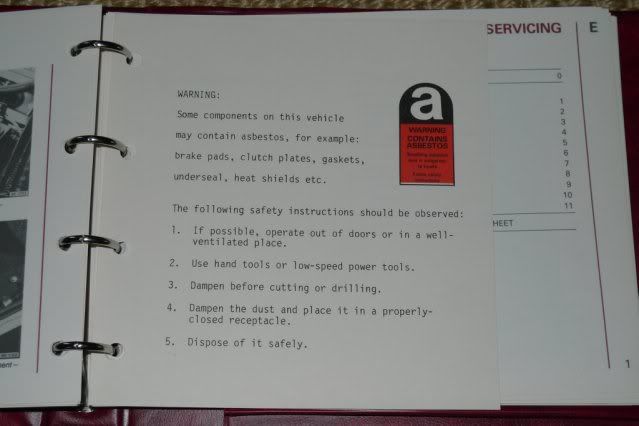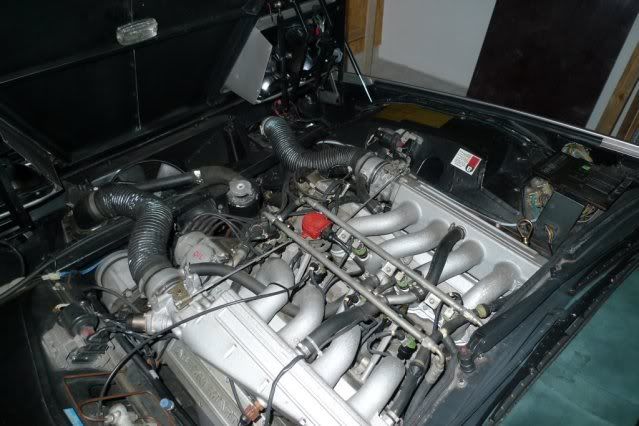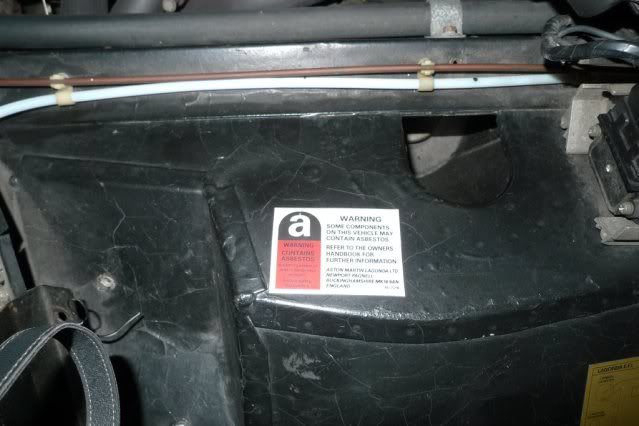| View previous topic :: View next topic |
| Author |
Message |
blacky
Joined: 14 Dec 2007
Posts: 5
Location: Germany
|
 Posted: Sat Oct 15, 2011 10:55 am Post subject: Asbestos warning Posted: Sat Oct 15, 2011 10:55 am Post subject: Asbestos warning |
 |
|
Hello fellow Lagondaists,
my Lagonda (#13498, 1986 US car) carries a Asbestos warning label in the engine compartment (inside of right wheelhouse, "a"-shaped symbol).
As I plan to have some mechanical work done on the chassis (unmounting and re-mounting of motor and aggregates, grinding, drilling holes, fixing consoles etc.) I am concerned where exactly in the car asbestos is located, and where we have to be careful. Is Asbestos used only for some panels underfloor, between exhaust system and chassis? Or is it somewhere distributed in the car, e.g. below the paint layer in the engine compartment?
Regards, Blacky. |
|
| Back to top |
|
 |
Lagondanet
Administrator

Joined: 03 Jan 2007
Posts: 3110
Location: UK
|
 Posted: Sat Oct 15, 2011 1:20 pm Post subject: Posted: Sat Oct 15, 2011 1:20 pm Post subject: |
 |
|
| Can you post a picture of the warning label? First I have heard of this. |
|
| Back to top |
|
 |
jonc
Joined: 21 Sep 2010
Posts: 584
Location: Cheshire, UK
|
 Posted: Sat Oct 15, 2011 3:57 pm Post subject: Posted: Sat Oct 15, 2011 3:57 pm Post subject: |
 |
|
I think this was a standard warning for brake linings. These days, brake linings don't contain asbestos, but precautions should be taken anyway to minimise and not inhale the brake dust.
Jonathan |
|
| Back to top |
|
 |
Lagondanet
Administrator

Joined: 03 Jan 2007
Posts: 3110
Location: UK
|
 Posted: Mon Oct 17, 2011 11:56 am Post subject: Posted: Mon Oct 17, 2011 11:56 am Post subject: |
 |
|
Blacky writes further:
I have posted a question about the asbestos warning in my cars (13498 and 13473, both have it, both are US cars from 1986).
Here are some photographs.
As far as brake pads and gaskets are concerned, I do not see a problem. But the text of the warning (see photo of inserted page in the US handbook) says something about underseal and heatshields.
I am most concerned about the underseal material. In the Lagonda 13498 the black paint cover inside the engine compartment shows many cracks, and the black paint is broken and has fallen apart on some places. Underneath an anthrazite grey surface appears, which possibly could be a layer of asbestos. Can you confirm this?
If yes: Is the whole steel structure of the car covered with such asbestos-containing material?



 |
|
| Back to top |
|
 |
Lagondanet
Administrator

Joined: 03 Jan 2007
Posts: 3110
Location: UK
|
 Posted: Mon Oct 17, 2011 1:52 pm Post subject: Posted: Mon Oct 17, 2011 1:52 pm Post subject: |
 |
|
David Marks writes:
The sign relates SOLELY to the asbestos compound that WAS in brake pads in
> the 1970's and '80's. Many UK cars that I have seen have this in the engine
> bay (Jaguar Bentley, RR, even Triumph, Austin etc.) so it was probably a
> mandatory requirement but you don't see it these days which implies that
> asbestos is no longer used in pads.
>
> Since probably late 1980's the asbestos in brake pads has been greatly
> reduced or eliminated (and most likely the latter).
>
> This means that brake discs now wear far more than they used to and we still
> have many older customers who cannot or refuse to) understand why discs
> rarely last more than 30K miles but used to last for 60 - 70.
>
> This was because the pad was far less abrasive on the disc as the asbestos
> had a greater friction coefficient without actually impacting on disc
> thickness, unlike modern compounds that (I presume) have more of a clamping
> and wear effect on the discs.
>
> Having completely stripped out four Lagondas now, (13150, 380, 397, and
> 501), including headliners in three of them, I have not found any evidence
> of any asbestos type material in the cabin or engine bays.
>
> I am not sure of the composition of the fibre boards that act as heat
> shields but as long as they are just removed and not broken up or powdered
> etc., I see no problem with them.>
and
Yes, some gaskets (such as exhaust, I suppose) may have an asbestos
compound.
I suspect that the base coat to the engine bay is a primer of some sort and
would be very surprised if it were asbestos.
I still think the label (now having seen the picture) is a bit of a "catch
all", in much the same way that (put simplistically) the notes that a packet
of peanuts "contains nuts" .
The main sources of asbestos were friction materials and as a Lagonda does
not have a manual gearbox, it is highly unlikely the average owner or
mechanic would be in contact with clutch plates inside the gearbox so this
just leaves the brake pads.
We have bare metalled three cars now and two have had the engine bay done as
well - 13150 and 501.
There were no concerns by the body shops that asbestos was being revealed.
Having said all that, if there are greater concerns, one may have to have
the relevant area sampled to see what it contains.
I've already commented about the heat shields, I think.
Last edited by Lagondanet on Mon Oct 17, 2011 8:48 pm; edited 2 times in total |
|
| Back to top |
|
 |
jonc
Joined: 21 Sep 2010
Posts: 584
Location: Cheshire, UK
|
 Posted: Mon Oct 17, 2011 3:47 pm Post subject: Posted: Mon Oct 17, 2011 3:47 pm Post subject: |
 |
|
Interestingly, there was an under seal which was bitumen impregnated with asbestos fibres to make it stronger; it was called Bittac (or Bittack). Looking at asbestos law, the spraying of asbestos-containing under seal was generally exempted from legislation, which to me says it is safe.
No idea whether it was used by AML, and in any case I can't see under seal ever creating dust which could be inhaled. |
|
| Back to top |
|
 |
Vincent

Joined: 20 Nov 2007
Posts: 1055
Location: Belgium
|
 Posted: Mon Oct 17, 2011 5:10 pm Post subject: Posted: Mon Oct 17, 2011 5:10 pm Post subject: |
 |
|
Hello guys,
Everybody out of us has inhaled asbestos at least once in his lifetime. So, don't worry !
Asbestos is forbidden in EC since the early '90s. In the US they had the '86US norm' wich was more restrictive than EC ones.
My car is a US one, with screens in the front wheel arches because of the heating caused by the catalyst which were mounted there. They contain(ed) asbestos to my opinion...
_________________
Welcome to Paradise ! (FRONT 242)
https://www.youtube.com/watch?v=XS30BC3D5WM |
|
| Back to top |
|
 |
Lagondanet
Administrator

Joined: 03 Jan 2007
Posts: 3110
Location: UK
|
 Posted: Mon Oct 17, 2011 8:51 pm Post subject: Posted: Mon Oct 17, 2011 8:51 pm Post subject: |
 |
|
| In any event I have passed Blacky's enquiry to AML Heritage Department for their comments. |
|
| Back to top |
|
 |
Lagondanet
Administrator

Joined: 03 Jan 2007
Posts: 3110
Location: UK
|
 Posted: Tue Oct 18, 2011 8:18 am Post subject: Posted: Tue Oct 18, 2011 8:18 am Post subject: |
 |
|
Blacky writes:
Thank you all for your valuable contributions up to now. Let´s see if Aston Martin Heritage center will bring us additional information. In the meantime I have made some more photographs, taken from the underfloor of #13473. One can see the grey "fibre plates" which David Marks had mentioned. They are neatly arranged around the exhaust system, and held by simple steel clamps. To me it seems quite likely that these plates could contain asbestos. Certainly they provide an effective heat insulation effect.
I agree with Vincent that no danger is emerging from these plates during normal installed condition. I do not want to rise panic. But I think for all people working on the cars it is good to know in which places asbestos material had been used during manufacturing of the Lagonda cars.Greetings, Blacky.

 |
|
| Back to top |
|
 |
Lagondanet
Administrator

Joined: 03 Jan 2007
Posts: 3110
Location: UK
|
 Posted: Tue Nov 01, 2011 12:15 pm Post subject: Posted: Tue Nov 01, 2011 12:15 pm Post subject: |
 |
|
AML state today:
This was a generic warning label which was used by all manufactures during the eighties and early nineties. It was basically stating asbestos has been used in known and unknown areas of the vehicle. So due diligence is required when working on and disposing of components.
There is not definitive list of the use of asbestos as component manufactures were not required disclose this information. Hence the vagueness of the statement. All components mentioned could all carry trace elements of asbestos but if the brake and clutch linings are not original then they are more likely to be asbestos free.
Current health and safety regulations are more than adequate. Gloves goggles mask not protective clothing etc. Your colleague will have to make enquires locally on disposal but normal measures should prevail as white asbestos was not used. |
|
| Back to top |
|
 |
|








